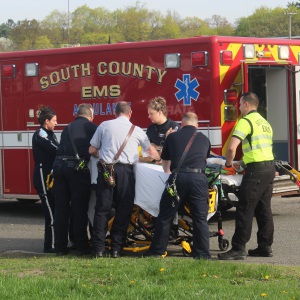My Turn: Let wildlife roam — An important new wildlife bill can help reconnect critical habitat

The author in Washington, D.C., last week building support for The Wildlife Movement Through Partnership Act. CONTRIBUTED
| Published: 04-17-2025 10:54 AM |
Humans are great at building things, but it’s also beginning to dawn on us that these impressive and sometimes magnificent structures also impact the other creatures that we share this earth with.
Some examples: When Amherst College built its new science center, an alarming number of birds crashed into the windows and died. In 2023, a semitruck driving on a road near Yellowstone struck and killed 13 bison. Or the sad and tragic tale of P-22, the mountain lion whose tragic story captured the imagination of Los Angeles.
The death of a single bird, squirrel or mountain lion may seem like an isolated event. But considered in the context of a larger biodiversity crisis where the total number of animals is shrinking and far too many species are moving closer and closer to extinction, at rates far above “normal” levels, it’s another thing altogether.
Habitat fragmentation harms animals.
Among the many threats animals face today, too many find their paths obstructed or their habitat damaged, encroached on or split up by human development.
This fragmentation can pen populations into an area that’s too small, forcing members of that population to inbreed, lowering genetic diversity and increasing disease susceptibility. Habitat fragmentation also can interrupt the natural processes and migration of animals, leading to population declines. And sometimes, animals have no choice but to attempt to cross a busy road to get where they need to go. And that’s risky for them. On average, one million vertebrate animals are struck and killed by motor vehicles in the U.S. every single day.
Wildlife corridors can help.
The idea behind wildlife corridors is quite simple. Animals migrate, often in semi-predictable ways. By studying their seasonal and daily patterns, and mapping their travels, we can better understand how to design infrastructure that won’t conflict as much with animals’ ability to go about their normal routines.
Article continues after...
Yesterday's Most Read Articles
 Northfield man dies in Erving motorcycle crash; Bernardston man injured in Deerfield crash
Northfield man dies in Erving motorcycle crash; Bernardston man injured in Deerfield crash
 Garage, house sustain ‘major damage’ in Phillips Street blaze in Greenfield
Garage, house sustain ‘major damage’ in Phillips Street blaze in Greenfield
 Extension cord under hay ‘being considered a potential factor’ in Leverett house fire
Extension cord under hay ‘being considered a potential factor’ in Leverett house fire
 Lesbian bar opens in Greenfield: Last Ditch is the new space for the Valley’s queer community
Lesbian bar opens in Greenfield: Last Ditch is the new space for the Valley’s queer community
 Real Estate Transactions: May 2, 2025
Real Estate Transactions: May 2, 2025
 New Salem town coordinator stepping down
New Salem town coordinator stepping down
In the United States, more than 1,000 wildlife corridors are currently in operation. One local example is the Henry Street salamander tunnel in North Amherst. Henry Street crosses between the wooded ridges where spotted salamanders spend most of their lives and the vernal pools where the salamanders mate and lay eggs. In the late 1980s, a community effort made it possible to build two tunnels under Henry Street and installed drift fences that guide the salamanders into the tunnels and protect them from being crushed by tires on Henry Street. A team of volunteers coordinated by the Hitchcock Center for the Environment helps maintain the tunnels and keep them free from debris.
Although there are still many unanswered questions about how to better design wildlife crossings, experts are beginning to evaluate their effectiveness and the data thus far is promising. Wildlife crossings have been shown to increase the gene flow and prevent vehicle collisions, reduce roadkill, and decrease stress levels in wildlife. And, when placed in areas of known wildlife movement, wildlife crossings with elements such as fencing have reduced wildlife-vehicle collisions by up to 97%.
We’re also learning that certain considerations must be taken into account to ensure they work as intended. Some animals prefer a certain type of crossing over another. We’re learning that elk, wolves, grizzly bears and deer prefer a wide, high and short crossing, whereas species like cougars and black bears prefer long and narrow underpasses. And that’s pretty different from the needs of ducks, who need a series of wetlands along their migration routes or monarch butterflies who need milkweed patches along theirs. Research also suggests that it can take wolves and bears as long as five years to get comfortable using newly established corridors.
Given the potential of wildlife corridors to help wildlife roam safely, it’s welcome news that U.S. Reps. Ryan Zinke of Montana and Don Beyer of Virginia have introduced The Wildlife Movement Through Partnerships Act. If passed, this bill would provide financial and technical assistance to promote habitat connectivity by funding efforts to conserve, restore and/or enhance habitat, migration routes and connectivity. The bill also would create a research program to improve our understanding of wildlife movement and migration routes, so we can place wildlife corridors where they will make the biggest impact.
As with many conservation issues, the bill is bipartisan, and it takes care to ensure that the creation of corridors is voluntary as it relates to private lands. That’s a smart path forward. I was proud to be in DC last week building support for this bill. If you’d like to join this effort and send a message to your members of Congress urging them to support this important wildlife bill, you can do so online at https://environmentamerica.org/take-action/tell-congress-give-wildlife-room-to-roam/.
Wildlife need space to roam, and the effort to save America’s wildlife needs precisely this type of bill.
Johanna Neumann of Amherst has spent the past two decades working to protect our air, water and open spaces, defend consumers in the marketplace and advance a more sustainable economy and democratic society.






 Kathy Sylvester: Tim Hilchey known for dependable leadership
Kathy Sylvester: Tim Hilchey known for dependable leadership Virginia and Howard Hastings: Vote Brassor for Northfield Selectboard
Virginia and Howard Hastings: Vote Brassor for Northfield Selectboard Susan Wright: Dan Campbell is best candidate for Northfield Selectboard
Susan Wright: Dan Campbell is best candidate for Northfield Selectboard Steve and Joan Stoia: Support Barbara Brassor for Select Board
Steve and Joan Stoia: Support Barbara Brassor for Select Board
